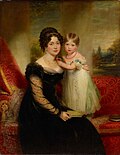Queen Victoria
Queen Victoria (24 May 1819 – 22 January 1901) was the Queen of the United Kingdom of Great Britain and Ireland from 20 June 1837 until her death in 1901. Known as the Victorian era, her reign of 63 years and seven months was longer than any previous British monarch. It was a period of industrial, cultural, political, scientific, and military changes within the United Kingdom, and was marked by a great expansion of the British Empire.
Early Life[edit]
Victoria was born at Kensington Palace, London, on 24 May 1819. She was the only daughter of Edward, Duke of Kent, and Victoria Maria Louisa of Saxe-Coburg. Her father died shortly after her birth, making Victoria a direct heir to the throne. She was raised under close supervision by her mother and her comptroller, Sir John Conroy.
Ascension to the Throne[edit]
Victoria became queen at the age of 18, following the death of her uncle, King William IV, in 1837. Her coronation took place on 28 June 1838. As a young queen, Victoria was eager to have an influence on British policy, but she was often frustrated by the constraints of her constitutional role and the willingness of her ministers to ignore her.
Marriage and Family[edit]
In 1840, Victoria married her first cousin, Prince Albert of Saxe-Coburg and Gotha. Their marriage produced nine children, all of whom married into various European royal and noble families. Prince Albert's death in 1861 was a devastating blow to Victoria, and she entered a period of deep mourning.
Later Reign and Death[edit]
During her later years, Victoria became the symbol of the British Empire. Her Golden and Diamond Jubilees were celebrated with great enthusiasm in the UK and the wider Empire. Victoria died on 22 January 1901, at Osborne House on the Isle of Wight. She was succeeded by her eldest son, Edward VII.
Legacy[edit]
Queen Victoria's reign marked a period of significant growth and progress for the United Kingdom. The Victorian era is known for its industrial expansion, moral strictness, and burgeoning of the arts and sciences. Victoria herself is remembered as a symbol of empire, and her monuments and memorials are scattered throughout the former British Empire.
-
Queen Victoria by Bassano
-
Victoria, Duchess of Kent with Princess Victoria by Sir William Beechey
-
Princess Victoria aged Four by Stephen Poyntz Denning
-
Princess Victoria and Dash by George Hayter
-
Victoria sketch 1835
-
Victoria to throne
-
Queen Victoria by Sir George Hayter
-
Victoria Marriage
-
Edward Oxford shoots at H. M. the Queen, 1840
-
Queen Victoria 1843 by Winterhalter
-
Queen Victoria the Princess Royal Victoria c1844-5
-
Queen Victoria, Prince Albert and their nine children
Ad. Transform your life with W8MD's Budget GLP-1 injections from $75


W8MD offers a medical weight loss program to lose weight in Philadelphia. Our physician-supervised medical weight loss provides:
- Weight loss injections in NYC (generic and brand names):
- Zepbound / Mounjaro, Wegovy / Ozempic, Saxenda
- Most insurances accepted or discounted self-pay rates. We will obtain insurance prior authorizations if needed.
- Generic GLP1 weight loss injections from $75 for the starting dose.
- Also offer prescription weight loss medications including Phentermine, Qsymia, Diethylpropion, Contrave etc.
NYC weight loss doctor appointmentsNYC weight loss doctor appointments
Start your NYC weight loss journey today at our NYC medical weight loss and Philadelphia medical weight loss clinics.
- Call 718-946-5500 to lose weight in NYC or for medical weight loss in Philadelphia 215-676-2334.
- Tags:NYC medical weight loss, Philadelphia lose weight Zepbound NYC, Budget GLP1 weight loss injections, Wegovy Philadelphia, Wegovy NYC, Philadelphia medical weight loss, Brookly weight loss and Wegovy NYC
|
WikiMD's Wellness Encyclopedia |
| Let Food Be Thy Medicine Medicine Thy Food - Hippocrates |
Medical Disclaimer: WikiMD is not a substitute for professional medical advice. The information on WikiMD is provided as an information resource only, may be incorrect, outdated or misleading, and is not to be used or relied on for any diagnostic or treatment purposes. Please consult your health care provider before making any healthcare decisions or for guidance about a specific medical condition. WikiMD expressly disclaims responsibility, and shall have no liability, for any damages, loss, injury, or liability whatsoever suffered as a result of your reliance on the information contained in this site. By visiting this site you agree to the foregoing terms and conditions, which may from time to time be changed or supplemented by WikiMD. If you do not agree to the foregoing terms and conditions, you should not enter or use this site. See full disclaimer.
Credits:Most images are courtesy of Wikimedia commons, and templates, categories Wikipedia, licensed under CC BY SA or similar.
Translate this page: - East Asian
中文,
日本,
한국어,
South Asian
हिन्दी,
தமிழ்,
తెలుగు,
Urdu,
ಕನ್ನಡ,
Southeast Asian
Indonesian,
Vietnamese,
Thai,
မြန်မာဘာသာ,
বাংলা
European
español,
Deutsch,
français,
Greek,
português do Brasil,
polski,
română,
русский,
Nederlands,
norsk,
svenska,
suomi,
Italian
Middle Eastern & African
عربى,
Turkish,
Persian,
Hebrew,
Afrikaans,
isiZulu,
Kiswahili,
Other
Bulgarian,
Hungarian,
Czech,
Swedish,
മലയാളം,
मराठी,
ਪੰਜਾਬੀ,
ગુજરાતી,
Portuguese,
Ukrainian













